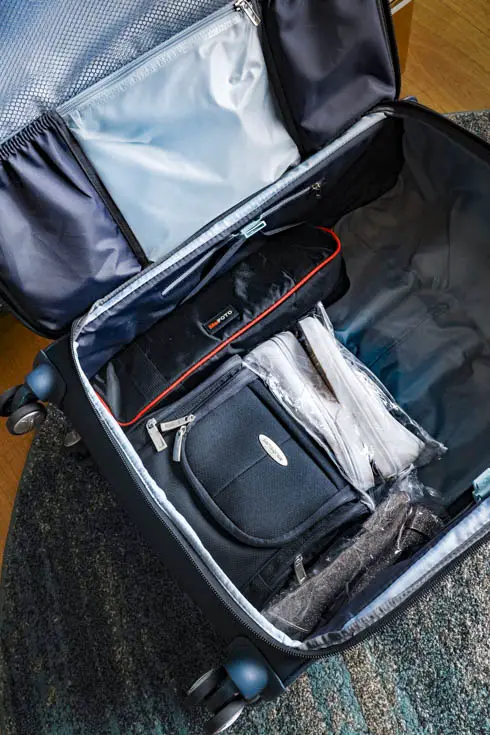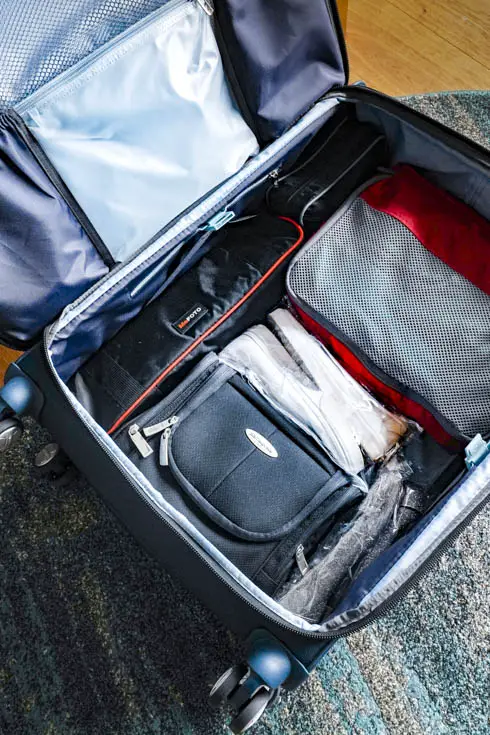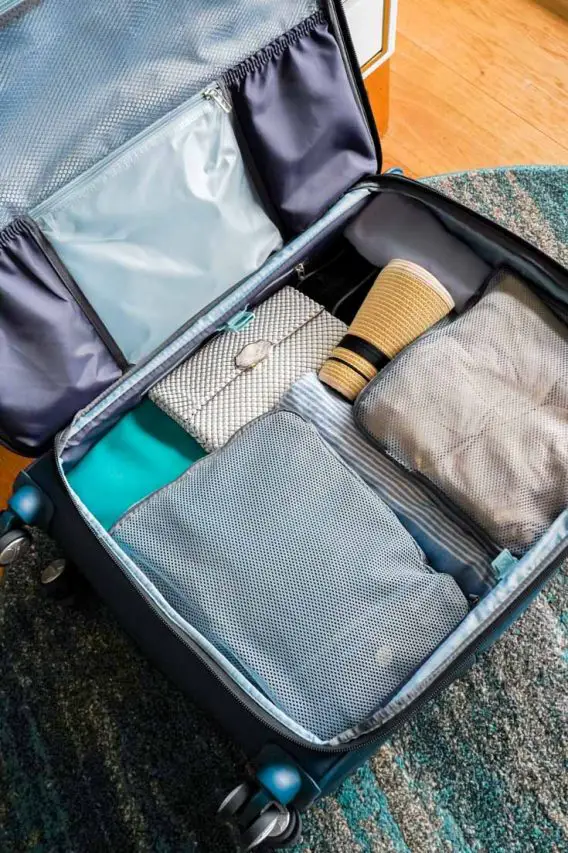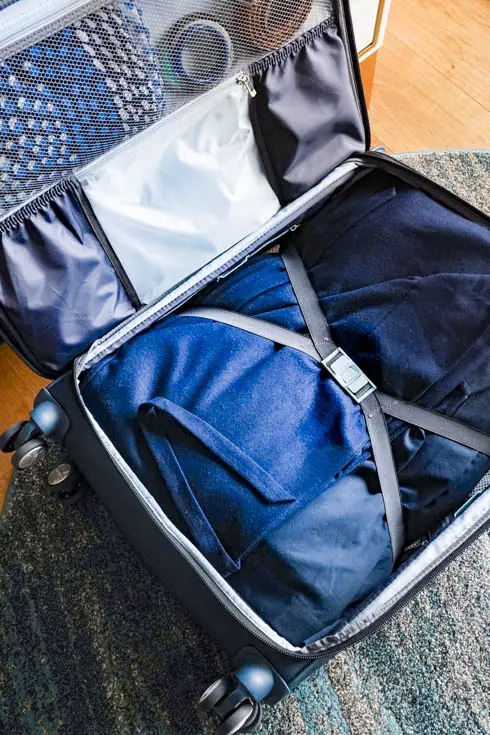I’m a packing geek. I love to curate a travel capsule wardrobe, hunt down and test drive compact, multipurpose (preferably eco-friendly) toiletries and play Tetris inside my suitcase. For this reason, you may occasionally find me with a glass of wine or cup of tea Googling “How to Pack a Suitcase”. There are tonnes of tips and video tutorials all over the interwebs – some are more helpful than others. After a decade of frequent travel, I’ve boiled down my most useful tips and techniques to share with you – step by step.
For more on travel fashion and packing geekery see:
21 Travel Essentials to Pack Every Time You Leave Home
DIY Travel Hacks Using Things You Already Own
7 Sources to Shop Your Sustainable Travel Wardrobe
My Travel Wardrobe Essentials and Why
Disclosure: I may earn compensation from the purchase of any product or service linked on this website, at no extra cost to you. I only link to products I use and love, therefore feel comfortable recommending.
What makes a perfect pack?
Let’s start with some quick criteria because everyone’s “perfect pack” will be slightly different. For instance, I love packing cubes (for reasons I’ll discuss later), while my husband, not so much. I like my clothing to be wrinkle-free, my husband doesn’t care unless it’s a business trip. So, it’s important to define exactly what we’re aiming for here:
- Room for everything you need with extra space for souvenirs.
- A manageable weight that can be comfortably lifted and carried in and out of vehicles, up flights of stairs etc.
- Wrinkle-free (or as close to as possible) and clean clothing.
- Organisation! Easy to locate items and remove them from the bag without completely unpacking.
Pre-Packing Strategies
Before I dive into how to pack a suitcase, let’s check that we have a few things in order thus far:
- Check the weather forecast AGAIN for your destination so you don’t overpack or select the wrong items.
- Use a packing list (there are packing lists for a variety of destinations right here on Duende, complete with printable checklists) to avoid forgetting essentials.
- Follow the “3-2-1” travel capsule wardrobe rule for short getaways to avoid overpacking.
- Select the right suitcase or bag to pack. Size. Style. Hardshell vs softshell. Carry-on vs checked luggage (more on how to make that decision here).
How to pack a suitcase, step-by-step
The below is a step-by-step guide in photos, showing how I build up the layer of items in my suitcase, carefully paying attention to weight distribution. Keep reading for more elaborate details on each step below. Plus, advice packing oddly-shaped and crushable items such as a wide-brim hat.




How to pack a suitcase
Weight distribution
If you’re using a suitcase with wheels (which I’ll refer to as a roller bag), start by putting your heavier items at the end of your case with the wheels. That way the weight will sit in the bottom end of the case when you turn it upright.
For example, I put my three heaviest items: toiletry bag, shoes and camera tripod in first, right down the bottom. This does two things. One, it keeps the centre of gravity low which prevents your suitcase from being top-heavy and toppling over. Two, your heavy items aren’t shifting around as much and putting weight on your clothing which contributes to creases and wrinkles.
Shoes
First up, pack your socks inside your shoes. The socks will help them keep their shape and if space is precious, you’ll save room. Some people recommend putting all sorts of items in your shoes, for me personally, putting anything but socks in your shoes is gross – unless you only travel with brand new shoes or you have magical feet that don’t sweat.
Next, pack shoes flat or soles together inside a bag. Soles are the dirtiest part of your shoes, so you don’t want the sole of one in contact with the top of the other (bye-bye lovely white tennis shoes), or with your clothes and other belongings for that matter. Ideally give your shoes a quick clean, at least remove loose dirt with a brush, before you pack them.
Rolling or folding
Both! Rolling is a great technique, but some fabrics just don’t lend themselves to it, usually the lighter, more delicate materials. Jeans, t-shirts and knitwear are roll-friendly, while dress shirts and silky blouses are better folded.
Bundle packing or wrapping
Another technique worthy of mention, if you are a slow traveller, cruiser, attending a special event or business traveller, is bundle wrapping. This method is entirely focused on keeping your items wrinkle-free, therefore it falls down in a lot of other areas. It’s great if you are making a short trip with a specific purpose, especially if you’re packing a business suit or evening dress. This technique is also fine if you’re staying in one place your entire getaway and you have the luxury of unpacking.
On the other hand, bundle packing is terrible at space efficiency and organization. If you’re a fast traveller or moving from place to place and don’t have time to unpack, you’ll find yourself doing just that – every time you want to get something out of your suitcase. I don’t like single-use plastic bags, but this is one place in your packing regime that they’re hard to replace. I use firm plastic, zipper bags that my bed linen came in when I bought it. They’ve lasted me years and saved many bin bags from landfill.
Packing cubes
Packing cubes are awesome! Well, I think so anyway. As I already alluded to, my husband isn’t a fan. He should probably write “the lazy man’s guide to packing a suitcase” because our approach varies significantly in this regard. I love that using cubes, I can lay my hand on anything I need in an instant, even if it’s at the bottom of the case. I only have to move aside a cube or two rather than unravel/unfold layers of clothing and put them all back again.
You can organize cubes however it suits. I use one for bottoms, one for tops, one for underwear, bras and socks, and a final cube for one-off items like a bathing suit and sarong, scarves, cocktail dress etc. You can roll and/or fold items inside the cubes. Note: I don’t necessarily put every item in cubes. If I have a larger item like a dress that I want to keep as flat as possible, I’ll leave that out. I will address items like this more in a moment.
Along with being great organization tools, packing cubes are useful as compression devices to save space. That’s why I recommend buying the best quality cubes you can afford – you don’t want to bust a cheap zipper or seam.
Jewellery
Let me begin by saying any valuable jewellery should NOT go in your checked bag. It should be with you at all times while you’re in transit, in your carry on or personal item if you’re flying. With that out of the way, for small items of jewellery, a pouch or roll great. I’ve had the same pouch since I was 18. It’s a little shaggy and discoloured now, but still works like a charm.
Compression straps
The straps inside your suitcase are compression straps, intended to hold everything in place. This helps to save a little more space but also stops things sliding around in your bag and wrinkling your clothes. For a long time I ignored those straps and now I don’t know what I was thinking! They are especially useful if you don’t have a full bag (ie space for souvenirs – wink, wink). Use these if you don’t want your bag looking like the inside of a washing machine when you get to your destination.
Dirty laundry
An old pillowcase makes a great laundry bag (unless you have wet items which should go in plastic). What I like the best about a pillowcase is that it is washable along with your laundry. I throw it right in there with my dirty clothes so it doesn’t accumulate dirt or smells and provides a clean bag to haul my freshly laundered clothing back to the hotel.
Toiletries
These days, toiletries are more complicated if you’re a carry-on only traveller. You will need an appropriately sized transparent bag with correct size bottles and containers, which is accessible at all times in transit to whip out at security checks.
If you are checking a bag or travelling by some other mode of transport, you can take a regular old toiletry bag. My go-to is a 15-yr old Samsonite (no longer available, but this is the very similar current model) that has an inbuilt hook for hanging to keep it off wet/dirty bathroom floors. To me, a great toiletry bag has lots of pockets and pouches for organisation, especially if you’re a cosmetics queen/king/non-binary monarch.
How to pack a wide-brim hat
To pack a hat so it keeps its shape, hollow out a cavity in the top of your case about the size and depth of the crown of your hat. Lie the hat in upside down so the crown sits in the space you just created and the brim lies flat on the surrounding items. Place some soft but firm items inside the crown of the hat, maybe a large rolled-up scarf or a small towel.
That one item
There’s always one. That thing which doesn’t fit any of the above. When it’s a clothing item, an evening dress, dinner jacket or big coat, I place it across the top of the suitcase right before I put the lid down. Using the entire real estate of the bag means you minimize folds and you can put it over or under the compression straps – over if your bag is really full, under if it needs holding in place.
Security
Lastly, make sure you have a padlock for your suitcase – even if it acts only as a deterent. A TSA-approved lock is worthwhile if you’re travelling in/out of the U.S.
Also, ensure you use some sort of luggage tracking system. Airlines cannot be relied upon. Having an Apple AirTag or similar to track your own bag, is becoming more and more critical as the volume of flights increases. This is particularly so if you making any kind of stopover or transfering flights on your journey, as this increases the likelyhood of your bag being left somewhere.
If you have any questions about travel or packing, please don’t hesitate to drop them in the comments below. Also, drop a comment if you would like to see a video demonstration on the above.
Peace, love & inspiring travel,
Madam ZoZo




